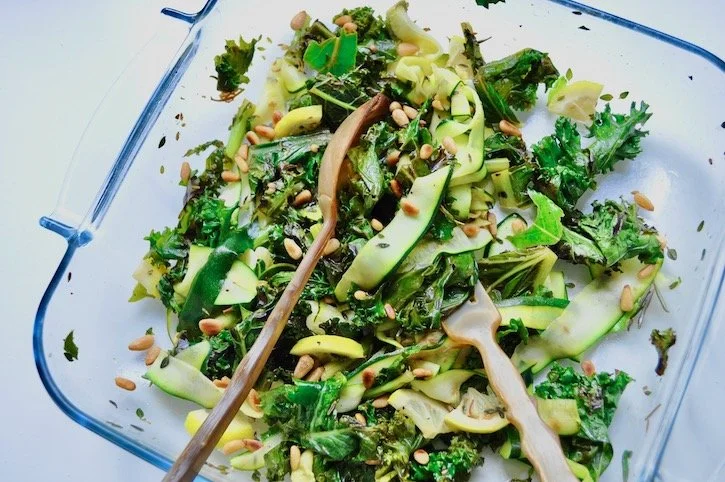Chuck-it-together chargrilled kale & courgette escabeche
There’s a narrow window of seasonal opportunity to make this salad when kale and courgette seasons fleetingly collide. Only August and September. But I think it’s best in August, when kale is just coming into season (it doesn’t hit its full stride until Sept) and you can still find small, young, beautifully tender courgettes.💚👌
Popular in Mediterranean and Latin American cuisines, escabeche simply refers to any dish marinated and cooked in an acidic mixture – generally vinegar, but they can include citrus. Traditionally made with fish or meat, veggies are a complete natural in the starring role.⭐ Briefly chargrilled, chucked into a tart vinaigrette (1:1 oil to vinegar versus the standard 3:1 ratio) with LOTS of herbs, a little spice, then marinated for a few hours to tenderise and drink up all the big, bold flavours.
As acidity tames bitterness, the dressing’s extra tartiness works beautifully with bitter greens like kale, toning down the pungency of its powerfully health-promoting glucosinolates (see next section for details). For extra gut love, raw apple cider or white wine vinegar adds a shot of probiotics to complement all the prebiotic veggie fibre and polyphenols.
As the ‘chuck-it-together’ name suggests, there’s considerable latitude for tweaking. Use whatever citrus, herbs and spices take your fancy, even switching up the veg if you like, although this pair are a great combo.
As easy as sear. Marinate. Exercise a little patience. Serve! 🍽😋
What’s great about it
One serving contains:
Nearly 4 of your ≥5-A-DAY
Almost a third of your weekly plant target
One sixth of your recommended daily intake of fibre (5g of 30g).
Like all cruciferous veg, kale is rich in glucosinolates, sulphur-containing phytochemicals that give them their pungent aroma and bitter flavour, protecting them from pests and herbivores. When we eat them, glucosinolates promote health and protect against many diseases including cancer, cardiovascular and neurological disease via antioxidant and anti-inflammatory mechanisms. Read more about the health benefits of glucosinolates here.
Olive oil is high in heart-healthy monounsaturated fat.
Extra virgin olive oil is extra rich in polyphenols, another class of phytochemicals. Like glucosinolates, olive oil polyphenols are antioxidant, anti-inflammatory, cardioprotective, neuroprotective, anticancer, and more. For maximum benefit, choose a high-phenolic olive oil such as The Governor.
As well as tasting fantastic, herbs top the list of the 100 richest dietary sources of antioxidants and polyphenols. [1]
In peak season
When UK-grown produce is at its best and most widely available:
Courgettes: June-September (going out October)
Kale: September-April (coming in August).
It’s possible to make this salad from August, when the first kale comes through, on into the end of courgette season in September/October. But, as mentioned above, I think it works best in August, when you can still find small, slender, tender courgettes.
How many of your ≥5-A-Day: 3.9 per serving
Plant points: 9 or 10
Time
Prep: 5-10 minutes
Cooking: 5-10 minutes
Ingredients (serves 2)
Dressing:
🍏Equal amounts of organic raw apple cider or white wine vinegar and the best quality, organic extra virgin olive oil that you can get your hands on – I used 2 tablespoons of each, more would give a lovely mopping sauce
🍊A squeeze of orange juice and/or lime juice*
🍋A few pieces of organic lemon, rind and all*
🍃Fresh bay and kaffir lime leaves, torn into pieces, discarding the tough central stems (I used 3 of each)
🌿Fresh lemon thyme and thyme, chopped roughly – be generous
✨Coriander, cumin and caraway seeds – toasted until fragrant and crushed lightly, I used 2 pinches of each
Finely ground pink Himalayan or sea salt
Freshly ground black pepper
Veg:
Approximately 150g each of:
🌿Organic kale
🥒Organic courgette, ribboned with a peeler
A great combination, but you can use whatever veg you wish.
Garnish:
Organic pine nuts
*Opt for organic as oranges, lemons, and many other citrus are on the PAN UK Dirty Dozen list.
Method
To make the dressing, add the vinegar, squeeze of orange and/or lime juice and salt to a large serving dish and mix until the salt has dissolved. Add the olive oil and freshly ground black pepper and, using a small balloon whisk, whisk to a smooth emulsion. Follow with the solid ingredients – the pieces of lemon, chopped herbs and crushed spices – and stir to combine.
Next, sear the vegetables on a very hot griddle, laying them flat on the surface of the pan so that they come into full contact with the scorching ridges. To avoid overlapping, you’ll need to cook the veg in several batches. I weighted down the kale with a side plate and left it long enough to form pretty (and tasty!) charred strips. The courgette I gave just a few seconds. As soon as each batch of veg is nicely ridged, throw it straight into the dressing.
Once all the veg have been added to the marinade, stir to combine, ensuring they are evenly coated.
Check the seasoning and adjust to your taste, adding more salt/pepper/oil/vinegar/citrus/herbs/spices as you wish.
Cover the dish and leave the vegetables to marinate for several hours or overnight. Opt for less time (2-4 hours) if you prefer the veg crunchy and big, bold flavours; longer for a softer, milder result.
Once ready, sprinkle with lightly toasted pine nuts and serve with whatever takes your fancy! 🍽😋
Recommended products & stockists
Fresh kaffir lime leaves are available from Waitrose and Sainsbury’s. Most Asian stores stock fresh and/or frozen. Frozen work just as well in this recipe.
Variations/Serving suggestions (delete as appropriate, if add both, duplicate this box)
Enter text here.
Enter text here.
References
Pérez-Jiménez J, Neveu V, Vos F, et al. Identification of the 100 richest dietary sources of polyphenols: an application of the Phenol-Explorer database. Eur J Clin Nutr. 2010;64:S112–S120. Available from: https://doi.org/10.1038/ejcn.2010.221.

